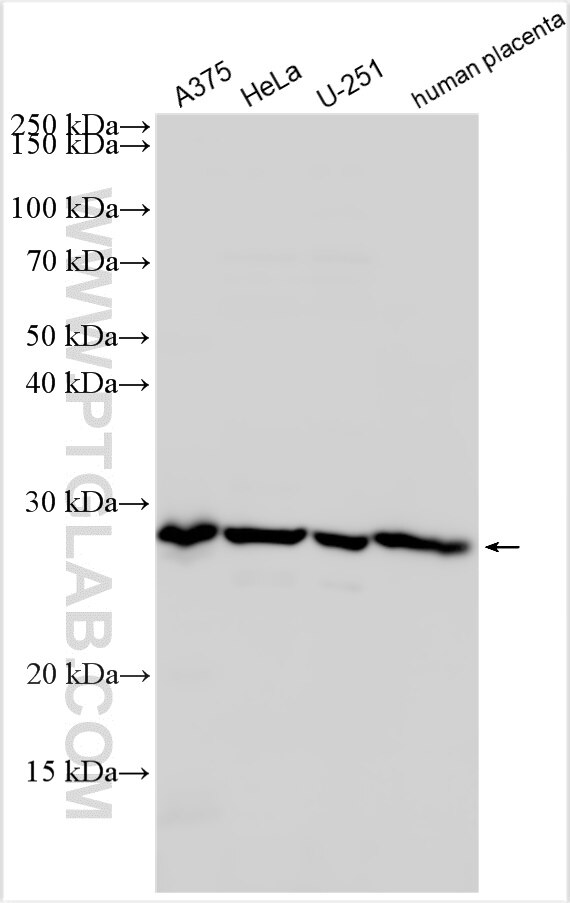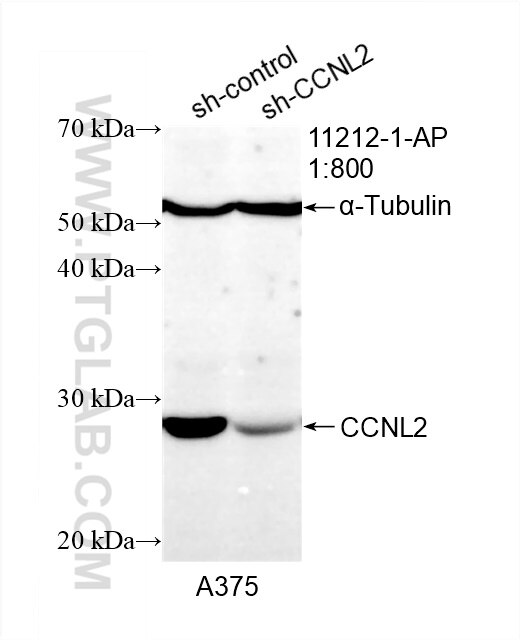Tested Applications
| Positive WB detected in | A375 cells, HeLa cells, U-251 cells, human placenta tissue |
Recommended dilution
| Application | Dilution |
|---|---|
| Western Blot (WB) | WB : 1:500-1:2000 |
| It is recommended that this reagent should be titrated in each testing system to obtain optimal results. | |
| Sample-dependent, Check data in validation data gallery. | |
Product Information
11212-1-AP targets CCNL2 in WB, ELISA applications and shows reactivity with human, mouse, rat samples.
| Tested Reactivity | human, mouse, rat |
| Host / Isotype | Rabbit / IgG |
| Class | Polyclonal |
| Type | Antibody |
| Immunogen | CCNL2 fusion protein Ag1710 Predict reactive species |
| Full Name | cyclin L2 |
| Calculated Molecular Weight | 58 kDa |
| Observed Molecular Weight | 28 kDa |
| GenBank Accession Number | BC016333 |
| Gene Symbol | CCNL2 |
| Gene ID (NCBI) | 81669 |
| RRID | AB_2073623 |
| Conjugate | Unconjugated |
| Form | Liquid |
| Purification Method | Antigen affinity purification |
| UNIPROT ID | Q96S94 |
| Storage Buffer | PBS with 0.02% sodium azide and 50% glycerol, pH 7.3. |
| Storage Conditions | Store at -20°C. Stable for one year after shipment. Aliquoting is unnecessary for -20oC storage. 20ul sizes contain 0.1% BSA. |
Background Information
CCNL2 (Cyclin-L2) is also named as SB138 and Paneth cell-enhanced expression protein. Human cyclin L2 is a novel member of the cyclin family. Human cyclin L2 shares significant homology to cyclin L1, K, T1, T2, and C, which are involved in transcriptional regulation via phosphorylation of the C-terminal domain of RNA polymerase II (PMID: 14684736). Cyclin L2 co-localizes with splicing factors SC-35 and 9G8 within nuclear speckles and that it associates with hyperphosphorylated, but not hypophosphorylated, RNA polymerase II and CDK p110 PITSLRE kinase via its N-terminal cyclin domains (PMID: 14684736). Human cyclin L2 is expressed ubiquitously in normal human tissues and tumor cells.
Protocols
| Product Specific Protocols | |
|---|---|
| WB protocol for CCNL2 antibody 11212-1-AP | Download protocol |
| Standard Protocols | |
|---|---|
| Click here to view our Standard Protocols |





